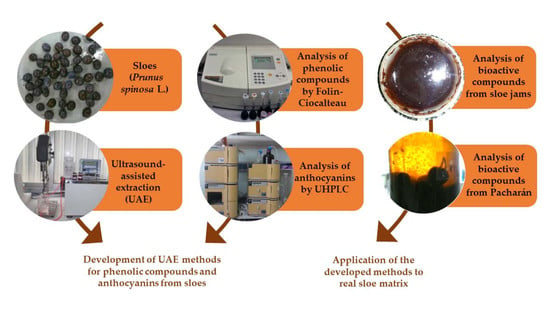Optimization of Analytical Ultrasound-Assisted Methods for the Extraction of Total Phenolic Compounds and Anthocyanins from Sloes (Prunus spinosa L.)
Abstract
:1. Introduction
2. Materials and Methods
2.1. Plant Material
2.2. Commercial Sloe Products
2.3. Chemicals and Solvents
2.4. Extraction of Bioactive Compounds
2.5. Determining Total Phenolic Compounds by Folin–Ciocalteu Assay
2.6. Identification of Anthocyanins by UHPLC-QToF-MS
2.7. Determination of Anthocyanins by UHPLC-UV–Vis
2.8. Experimental Design Analysis
3. Results and Discussion
3.1. Experimental Design of the Extraction Method for Total Phenolic Compounds
3.2. Experimental Design of the Method for the Extraction of Total Anthocyanins from Sloes
3.3. Optimal Conditions
3.3.1. Total Phenolic Compounds
3.3.2. Total Anthocyanins
3.3.3. Comparison Between Total Phenolic Compounds and Anthocyanins
3.4. Study of the Optimal Extraction Time
3.5. Method Accuracy
3.6. Re-Extraction Study
3.7. Applying the Developed Methods to Real Sloe Matrices
3.7.1. Extraction and Analysis of the Bioactive Compounds in “Pacharán”
3.7.2. Extraction and Analysis of the Bioactive Compounds from Sloe Jams
4. Conclusions
Author Contributions
Funding
Acknowledgments
Conflicts of Interest
References
- Gündüz, G.T. Antimicrobial activity of sloe berry purees on Salmonella spp. Food Control 2013, 32, 354–358. [Google Scholar] [CrossRef]
- Cosmulescu, S.; Trandafir, I.; Nour, V. Phenolic acids and flavonoids profiles of extracts from edible wild fruits and their antioxidant properties. Int. J. Food Prop. 2017, 20, 3124–3134. [Google Scholar] [CrossRef] [Green Version]
- Yang, C.; Li, F.; Du, B.; Chen, B.; Wang, F.; Wang, M. Isolation and characterization of new phenolic compounds with estrogen biosynthesis-inhibiting and antioxidation activities from Broussonetia papyrifera leaves. PLoS ONE 2014, 9, e94198. [Google Scholar] [CrossRef] [PubMed]
- Mikulic-Petkovsek, M.; Stampar, F.; Veberic, R.; Sircelj, H. Wild Prunus Fruit Species as a Rich Source of Bioactive Compounds. J. Food Sci. 2016, 81, 1928–1937. [Google Scholar] [CrossRef]
- Gironés-Vilaplana, A.; Mena, P.; Moreno, D.A.; García-Viguera, C. Evaluation of sensorial; phytochemical and biological properties of new isotonic beverages enriched with lemon and berries during shelf life. J. Sci. Food Agric. 2014, 94, 1090–1100. [Google Scholar] [CrossRef]
- Eimert, K.; Hüwe, U.; Rückert, F.-E. Evaluation of genetic differentiation of autochthonous sloe (Prunus spinosa; rosaceae) populations across Germany using molecular markers. Plant Ecol. Evol. 2016, 149, 280–290. [Google Scholar] [CrossRef]
- Kavaz Yuksel, A. The Effects of Blackthorn (Prunus Spinosa L.) Addition on Certain Quality Characteristics of Ice Cream. J. Food Qual. 2015, 38, 413–421. [Google Scholar] [CrossRef] [Green Version]
- Baltas, N.; Pakyildiz, S.; Can, Z.; Dincer, B.; Kolayli, S. Biochemical properties of partially purified polyphenol oxidase and phenolic compounds of Prunus spinosa L. subsp. dasyphylla as measured by HPLC-UV. Int. J. Food Prop. 2017, 20, 1–15. [Google Scholar] [CrossRef]
- Guimarães, R.; Barros, L.; Dueñas, M.; Carvalho, A.M.; Queiroz, M.J.R.P.; Santos-Buelga, C.; Ferreira, I.C.F.R. Characterisation of phenolic compounds in wild fruits from Northeastern Portugal. Food Chem. 2013, 141, 3721–3730. [Google Scholar] [CrossRef] [Green Version]
- Pinacho, R.; Cavero, R.Y.; Astiasarán, I.; Ansorena, D.; Calvo, M.I. Phenolic compounds of blackthorn (Prunus spinosa L.) and influence of in vitro digestion on their antioxidant capacity. J. Funct. Foods 2015, 19, 49–62. [Google Scholar] [CrossRef]
- Sokoł-Łȩtowska, A.; Kucharska, A.Z.; Wińska, K.; Szumny, A.; Nawirska-Olszańska, A.; Mizgier, P.; Wyspiańska, D. Composition and antioxidant activity of red fruit liqueurs. Food Chem. 2014, 157, 533–539. [Google Scholar] [CrossRef] [PubMed]
- Barros, L.; Carvalho, A.M.; Morais, J.S.; Ferreira, I.C.F.R. Strawberry-tree; blackthorn and rose fruits: Detailed characterisation in nutrients and phytochemicals with antioxidant properties. Food Chem. 2010, 120, 247–254. [Google Scholar] [CrossRef]
- Lovrić, V.; Putnik, P.; Bursać Kovačević, D.; Jukić, M.; Dragović-Uzelac, V. The Effect of Microwave-Assisted Extraction on the Phenolic Compounds and Antioxidant Capacity of Blackthorn Flowers. Food Technol. Biotechnol. 2017, 55, 243–250. [Google Scholar] [CrossRef] [PubMed]
- Pradal, D.; Vauchel, P.; Decossin, S.; Dhulster, P.; Dimitrov, K. Kinetics of ultrasound-assisted extraction of antioxidant polyphenols from food by-products: Extraction and energy consumption optimization. Ultrason. Sonochem. 2016, 32, 137–146. [Google Scholar] [CrossRef] [PubMed]
- Dai, J.; Mumper, R.J. Plant phenolics: Extraction; analysis and their antioxidant and anticancer properties. Molecules 2010, 15, 7313–7352. [Google Scholar] [CrossRef]
- Mason, T.J.; Paniwnyk, L.; Lorimer, J.P. The uses of ultrasound in food technology. Ultrason. Sonochem. 1996, 3, 253–260. [Google Scholar] [CrossRef]
- Espada-Bellido, E.; Ferreiro-González, M.; Carrera, C.; Palma, M.; Barroso, C.G.; Barbero, G.F. Optimization of the ultrasound-assisted extraction of anthocyanins and total phenolic compounds in mulberry (Morus nigra) pulp. Food Chem. 2017, 219, 23–32. [Google Scholar] [CrossRef]
- Pasquel Reátegui, J.L.; Machado, A.P.D.F.; Barbero, G.F.; Rezende, C.A.; Martínez, J. Extraction of antioxidant compounds from blackberry (Rubus sp.) bagasse using supercritical CO2 assisted by ultrasound. J. Supercrit Fluids 2014, 94, 223–233. [Google Scholar] [CrossRef]
- González-Centeno, M.R.; Comas-Serra, F.; Femenia, A.; Rosselló, C.; Simal, S. Effect of power ultrasound application on aqueous extraction of phenolic compounds and antioxidant capacity from grape pomace (Vitis vinifera L.): Experimental kinetics and modeling. Ultrason. Sonochem. 2015, 22, 506–514. [Google Scholar] [CrossRef] [Green Version]
- Živković, J.; Šavikin, K.; Janković, T.; Ćujić, N.; Menković, N. Optimization of ultrasound-assisted extraction of polyphenolic compounds from pomegranate peel using response surface methodology. Sep. Purif. Technol. 2018, 194, 40–47. [Google Scholar] [CrossRef]
- Elez Garofulić, I.; Zorić, Z.; Pedisić, S.; Brnčić, M.; Dragović-Uzelac, V. UPLC-MS 2 Profiling of Blackthorn Flower Polyphenols Isolated by Ultrasound-Assisted Extraction. J. Food Sci. 2018, 83, 2782–2789. [Google Scholar] [CrossRef] [PubMed]
- Leichtweis, M.G.; Pereira, C.; Prieto, M.A.; Barreiro, M.F.; Baraldi, I.J.; Barros, L.; Ferreira, I.C.F.R. Ultrasound as a Rapid and Low-Cost Extraction Procedure to Obtain Anthocyanin-Based Colorants from Prunus spinosa L. Fruit epicarp: Comparative study with conventional heat-based extraction. Molecules 2019, 24, 1–17. [Google Scholar] [CrossRef] [PubMed] [Green Version]
- González de Peredo, A.V.; Vázquez-Espinosa, M.; Espada-Bellido, E.; Ferreiro-González, M.; Amores-Arrocha, A.; Palma, M.; Barbero, G.F.; Jiménez-Cantizano, A. Alternative Ultrasound-Assisted Method for the Extraction of the Bioactive Compounds Present in Myrtle (Myrtus communis L.). Molecules 2019, 24, 882. [Google Scholar] [CrossRef] [PubMed] [Green Version]
- Aliaño-González, M.J.; Espada-Bellido, E.; Ferreiro-González, M.; Carrera, C.; Palma, M.; Ayuso, J.; Álvarez, J.A.; Barbero, G.F. Extraction of Anthocyanins and Total Phenolic Compounds from Açai (Euterpe oleracea Mart.) Using an Experimental Design Methodology. Part 2: Ultrasound-Assisted Extraction. Agronomy 2020, 10, 326. [Google Scholar] [CrossRef] [Green Version]
- Espada-Bellido, E.; Ferreiro-González, M.; Carrera, C.; Palma, M.; Álvarez, J.A.; Barbero, G.F.; Ayuso, J. Extraction of Antioxidants from Blackberry (Rubus ulmifolius L.): Comparison between Ultrasound and Microwave Assisted Extraction Techniques. Agronomy 2019, 9, 745. [Google Scholar] [CrossRef] [Green Version]
- Vázquez-Espinosa, M.; González de Peredo, A.V.; Espada-Bellido, E.; Ferreiro-González, M.; Toledo-Domínguez, J.J.; Carrera, C.; Palma, M.; Barbero, G.F. Ultrasound-Assisted Extraction of Two Types of Antioxidant Compounds (TPC and TA) from Black Chokeberry (Aronia melanocarpa L.): Optimization of the Individual and Simultaneous Extraction Methods. Agronomy 2019, 9, 456. [Google Scholar] [CrossRef] [Green Version]
- Vázquez-Espinosa, M.; González de Peredo, A.V.; Ferreiro-González, M.; Carrera, C.; Palma, M.; Barbero, G.F.; Espada-Bellido, E. Assessment of ultrasound assisted extraction as an alternative method for the extraction of anthocyanins and total phenolic compounds from maqui berries (Aristotelia chilensis (Mol.) Stuntz). Agronomy 2019, 9, 148. [Google Scholar] [CrossRef] [Green Version]
- Singleton, V.L.; Orthofer, R.; Lamuela-Raventós, R.M. Analysis of total phenols and other oxidation substrates and antioxidants by means of folin-ciocalteu reagent. Methods Enzymol. 1999, 299, 152–178. [Google Scholar] [CrossRef]
- Siddiq, M.; Dolan, K.D.; Perkins-Veazie, P.; Collins, J.K. Effect of pectinolytic and cellulytic enzymes on the physical; chemical; and antioxidant properties of blueberry (Vaccinium corymbosum L.) juice. LWT-Food Sci. Technol. 2018, 92, 127–132. [Google Scholar] [CrossRef]
- Hogan, S.; Chung, H.; Zhang, L.; Li, J.; Lee, Y.; Dai, Y.; Zhou, K. Antiproliferative and antioxidant properties of anthocyanin-rich extract from açai. Food Chem. 2010, 118, 208–214. [Google Scholar] [CrossRef]
- Ferreira, S.L.C.; Bruns, R.E.; Ferreira, H.S.; Matos, G.D.; David, J.M.; Brandão, G.C.; da Silva, E.G.P.; Portugal, L.A.; dos Reis, P.S.; Souza, A.S.; et al. Box-Behnken design: An alternative for the optimization of analytical methods. Anal. Chim. Acta 2007, 597, 179–186. [Google Scholar] [CrossRef] [PubMed]
- Maran, J.; Manikandan, S.; Thirugnanasambandham, K.; Vigna Nivetha, C.; Dinesh, R. Box-Behnken design based statistical modeling for ultrasound-assisted extraction of corn silk polysaccharide. Carbohydr. Polym. 2013, 92, 604–611. [Google Scholar] [CrossRef]
- Setyaningsih, W.; Saputro, I.E.; Carrera, C.A.; Palma, M.; Barroso, C.G. Multiresponse optimization of a UPLC method for the simultaneous determination of tryptophan and 15 tryptophan-derived compounds using a Box-Behnken design with a desirability function. Food Chem. 2017, 225, 1–9. [Google Scholar] [CrossRef] [PubMed]
- Li, H.; van den Driesche, S.; Bunge, F.; Yang, B.; Vellekoop, M.J. Optimization of on-chip bacterial culture conditions using the Box-Behnken design response surface methodology for faster drug susceptibility screening. Talanta 2019, 194, 627–633. [Google Scholar] [CrossRef] [PubMed]
- Fernández-Barbero, G.; Pinedo, C.; Espada-Bellido, E.; Ferreiro-González, M.; Carrera, C.; Palma, M.; García-Barroso, C. Optimization of ultrasound-assisted extraction of bioactive compounds from jabuticaba (Myrciaria cauliflora) fruit through a Box-Behnken experimental design. Food Sci. Technol. 2019, 9, 745. [Google Scholar] [CrossRef] [Green Version]
- Machado, A.P.D.F.; Pasquel-Reátegui, J.L.; Barbero, G.F.; Martínez, J. Pressurized liquid extraction of bioactive compounds from blackberry (Rubus fruticosus L.) residues: A comparison with conventional methods. Food Res. Int. 2015, 77, 675–678. [Google Scholar] [CrossRef]
- Mustafa, A.; Turner, C. Pressurized liquid extraction as a green approach in food and herbal plants extraction: A review. Anal. Chim. Acta 2011, 703, 8–18. [Google Scholar] [CrossRef]
- Kidak, R.; Ince, N.H. Ultrasonic destruction of phenol and substituted phenols: A review of current research. Ultrason. Sonochem. 2006, 13, 195–199. [Google Scholar] [CrossRef]
- Machado, A.P.D.F.; Pereira, A.L.D.; Barbero, G.F.; Martínez, J. Recovery of anthocyanins from residues of Rubus fruticosus; Vaccinium myrtillus and Eugenia brasiliensis by ultrasound assisted extraction; pressurized liquid extraction and their combination. Food Chem. 2017, 231, 1–10. [Google Scholar] [CrossRef]
- Hashemi, S.M.B.; Michiels, J.; Asadi Yousefabad, S.H.; Hosseini, M. Kolkhoung (Pistacia khinjuk) kernel oil quality is affected by different parameters in pulsed ultrasound-assisted solvent extraction. Ind. Crops. Prod. 2015, 70, 28–33. [Google Scholar] [CrossRef]
- You, Q.; Yin, X.; Ji, C. Pulsed counter-current ultrasound-assisted extraction and characterization of polysaccharides from Boletus edulis. Carbohydr. Polym. 2014, 101, 379–385. [Google Scholar] [CrossRef]
- Pereira, D.T.V.; Tarone, A.G.; Cazarin, C.B.B.; Barbero, G.F.; Martínez, J. Pressurized liquid extraction of bioactive compounds from grape marc. J. Food Eng. 2019, 240, 105–113. [Google Scholar] [CrossRef]
- Barnes, J.S.; Nguyen, H.P.; Shen, S.; Schug, K.A. General method for extraction of blueberry anthocyanins and identification using high performance liquid chromatography-electrospray ionization-ion trap-time of flight-mass spectrometry. J. Chromatogr. A 2009, 1216, 4728–4735. [Google Scholar] [CrossRef] [PubMed]
- Cai, Z.; Qu, Z.; Lan, Y.; Zhao, S.; Ma, X.; Wan, Q.; Jing, P.; Li, P. Conventional; ultrasound-assisted; and accelerated-solvent extractions of anthocyanins from purple sweet potatoes. Food Chem. 2016, 197, 266–272. [Google Scholar] [CrossRef] [PubMed]
- Carrera, C.; Ruiz-Rodríguez, A.; Palma, M.; Barroso, C.G. Ultrasound assisted extraction of phenolic compounds from grapes. Anal. Chim. Acta 2012, 732, 100–104. [Google Scholar] [CrossRef]
- Espada-Bellido, E.; Ferreiro-González, M.; Barbero, G.F.; Carrera, C.; Palma, M.; Barroso, C.G. Alternative Extraction Method of Bioactive Compounds from Mulberry (Morus nigra L.) Pulp Using Pressurized-Liquid Extraction. Food Anal. Methods 2018, 11, 2384–2395. [Google Scholar] [CrossRef]
- Vázquez-Espinosa, M.; González de Peredo, A.V.; Ferreiro-González, M.; Palma, M.; Carrera, C.; Barroso, C.G.; Barbero, G.F. Optimization of Microwave-Assisted Extraction for the Recovery of Bioactive Compounds from the Chilean Superfruit (Aristotelia chilensis (Mol.) Stuntz). Agronomy 2018, 8, 240. [Google Scholar] [CrossRef] [Green Version]
- Barbero, G.F.; Liazid, A.; Palma, M.; Barroso, C.G. Ultrasound-assisted extraction of capsaicinoids from peppers. Talanta 2008, 75, 1332–1337. [Google Scholar] [CrossRef]
- Santos, D.T.; Veggi, P.C.; Meireles, M.A.A. Optimization and economic evaluation of pressurized liquid extraction of phenolic compounds from jabuticaba skins. J. Food Eng. 2012, 108, 444–452. [Google Scholar] [CrossRef] [Green Version]
- Türker, N.; Erdoǧdu, F. Effects of pH and temperature of extraction medium on effective diffusion coefficient of anthocynanin pigments of black carrot (Daucus carota var. L.). J. Food Eng. 2006, 76, 579–583. [Google Scholar] [CrossRef]
- Peron, D.V.; Fraga, S.; Antelo, F. Thermal degradation kinetics of anthocyanins extracted from juçara (Euterpe edulis Martius) and “Italia” grapes (Vitis vinifera L.); and the effect of heating on the antioxidant capacity. Food Chem. 2017, 232, 836–840. [Google Scholar] [CrossRef] [PubMed]
- Luque de Castro, M.D.; Priego-Capote, F. Ultrasound assistance to liquid-liquid extraction: A debatable analytical tool. Anal. Chim. Acta 2007, 583, 2–9. [Google Scholar] [CrossRef] [PubMed]
- AOAC (Ed.) AOAC Peer Verified Methods Program. In A International, Manual on Policies and Procedures; Maryland: Arlingt, VA, USA, 1998. [Google Scholar]
- Gironés-Vilaplana, A.; Calín-Sánchez, Á.; Moreno, D.A.; Carbonell-Barrachina, Á.A.; García-Viguera, C. Novel maqui liquor using traditional pacharán processing. Food Chem. 2015, 173, 1228–1235. [Google Scholar] [CrossRef] [PubMed]

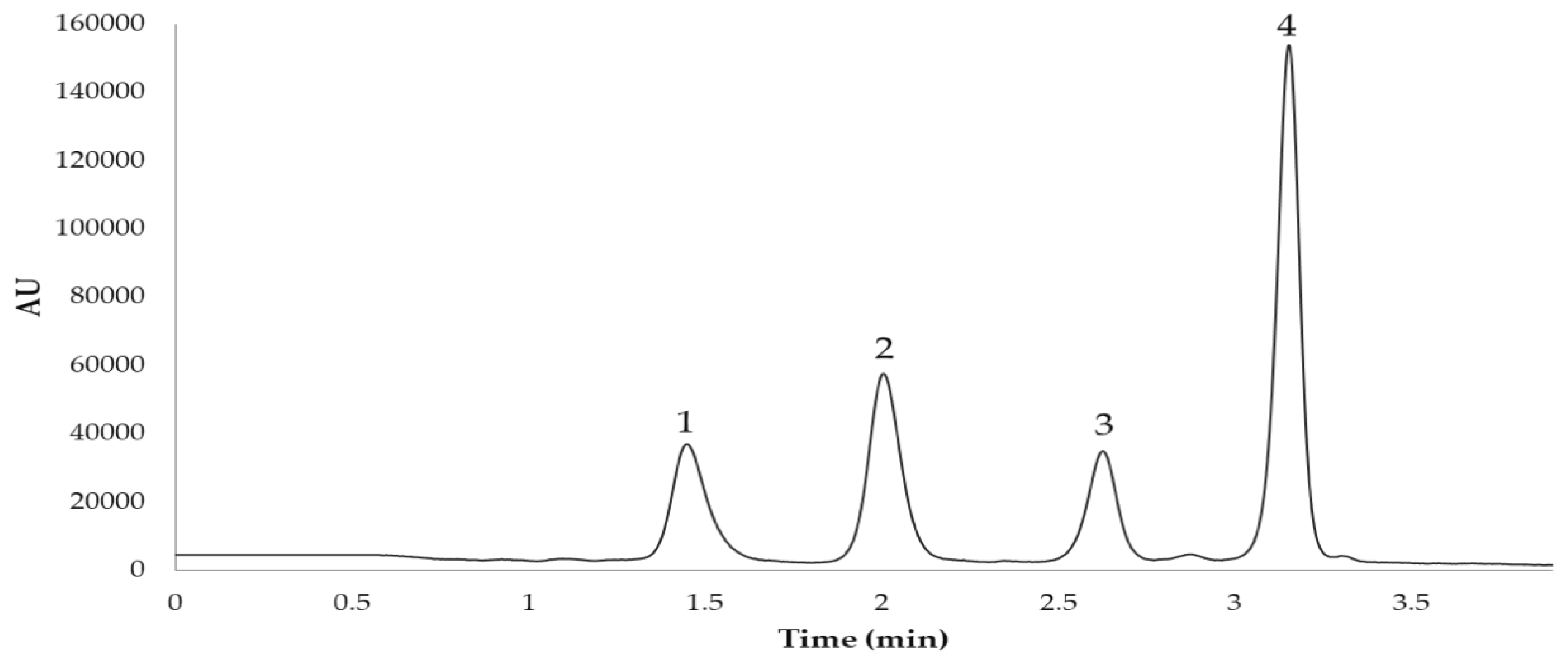
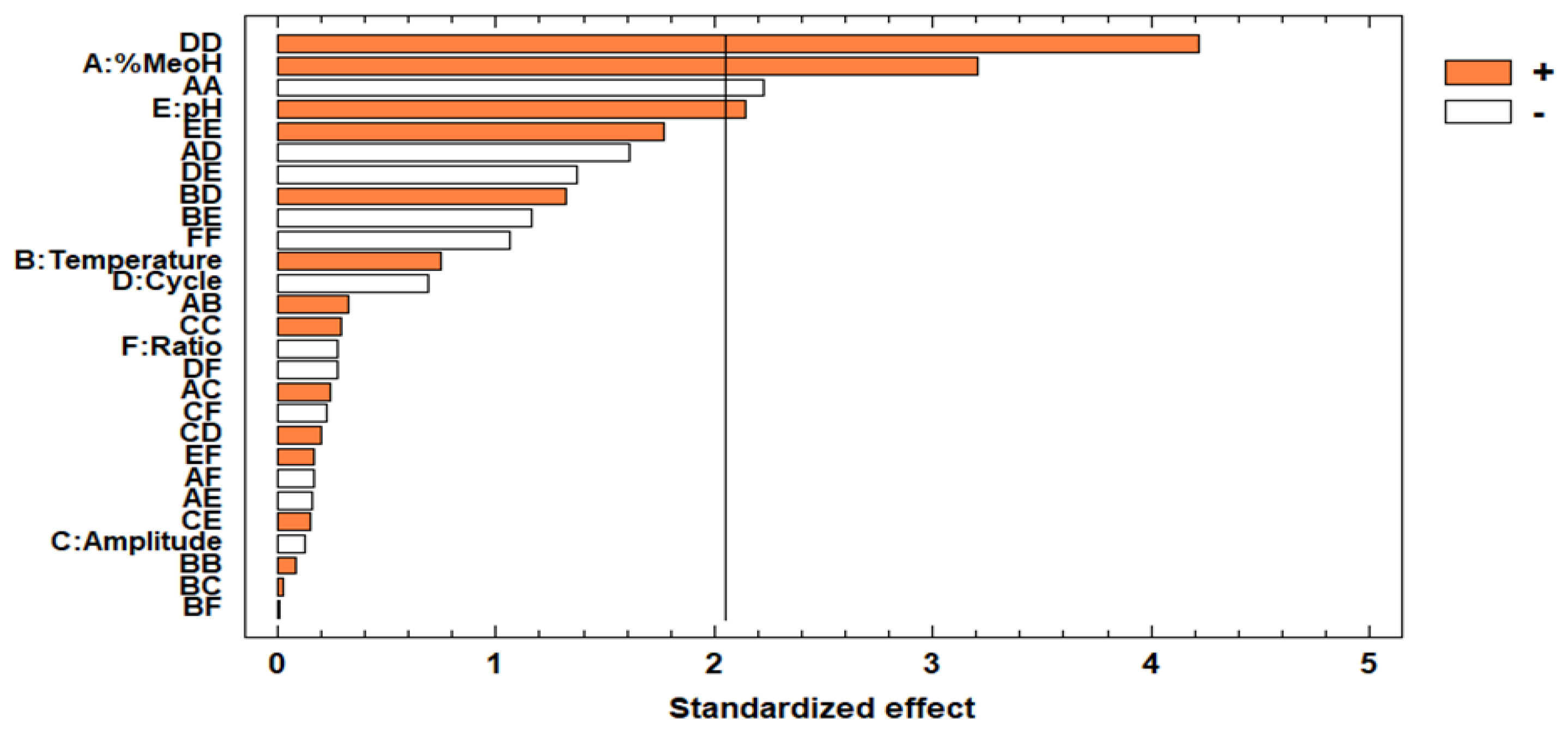
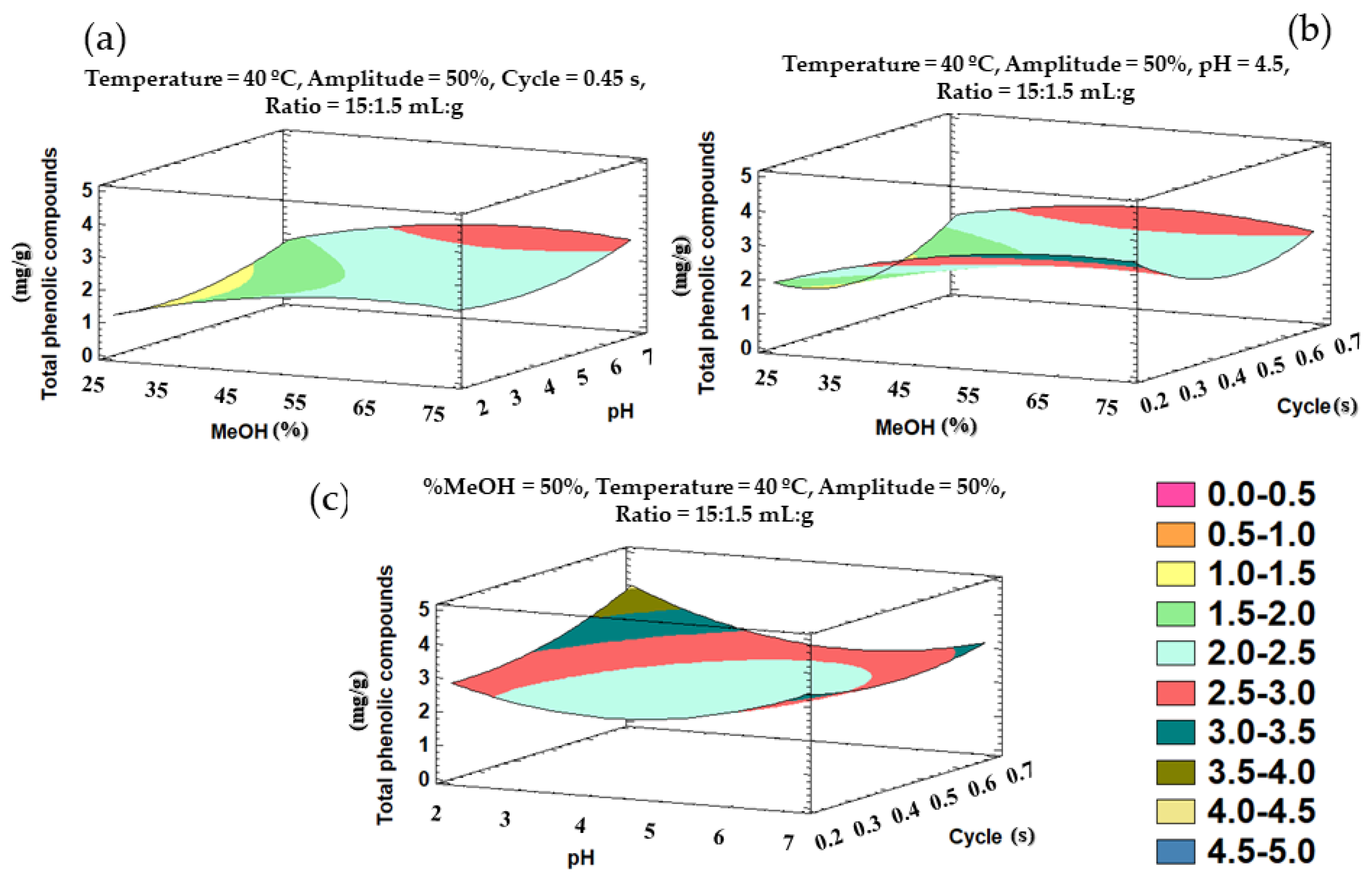

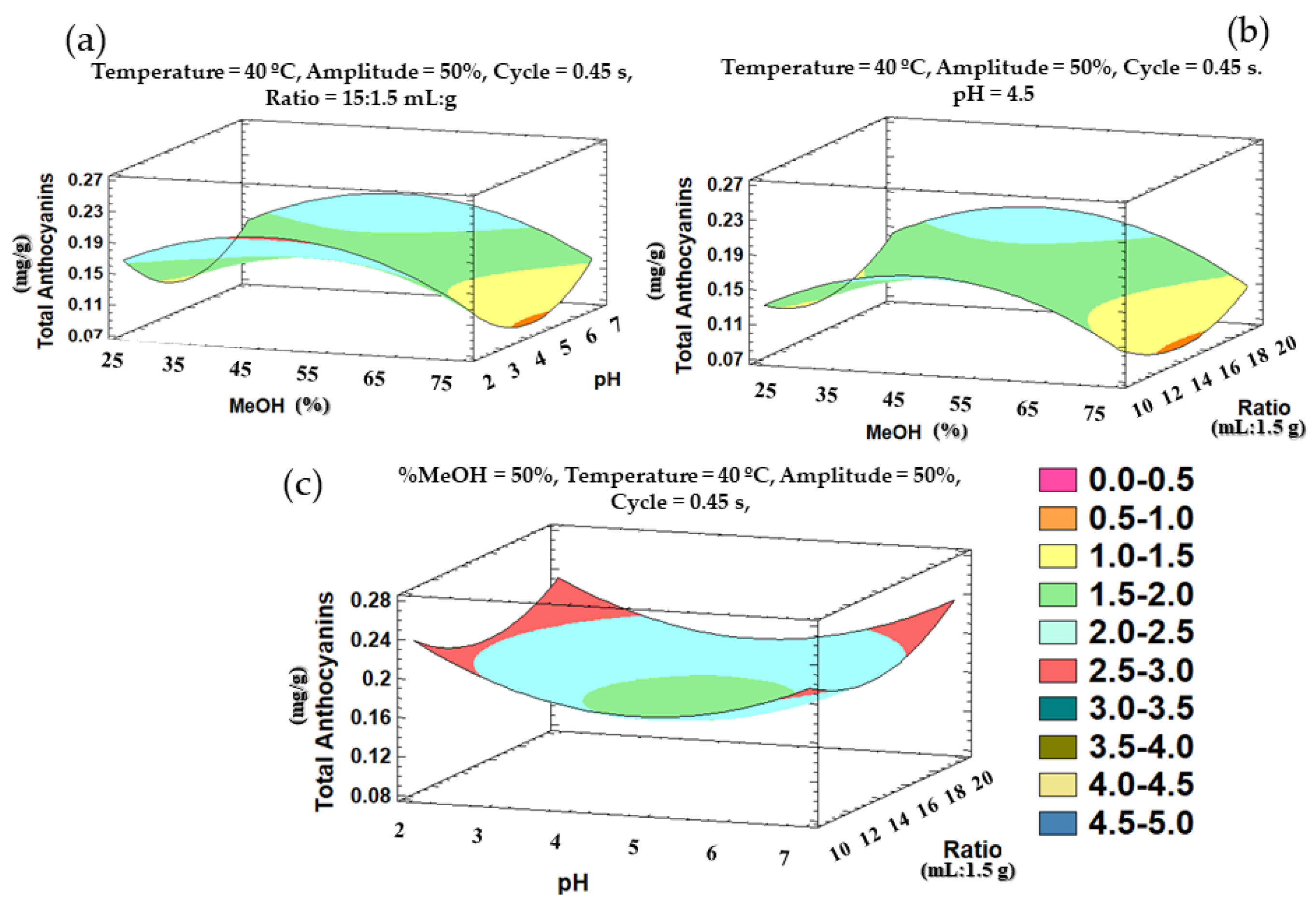
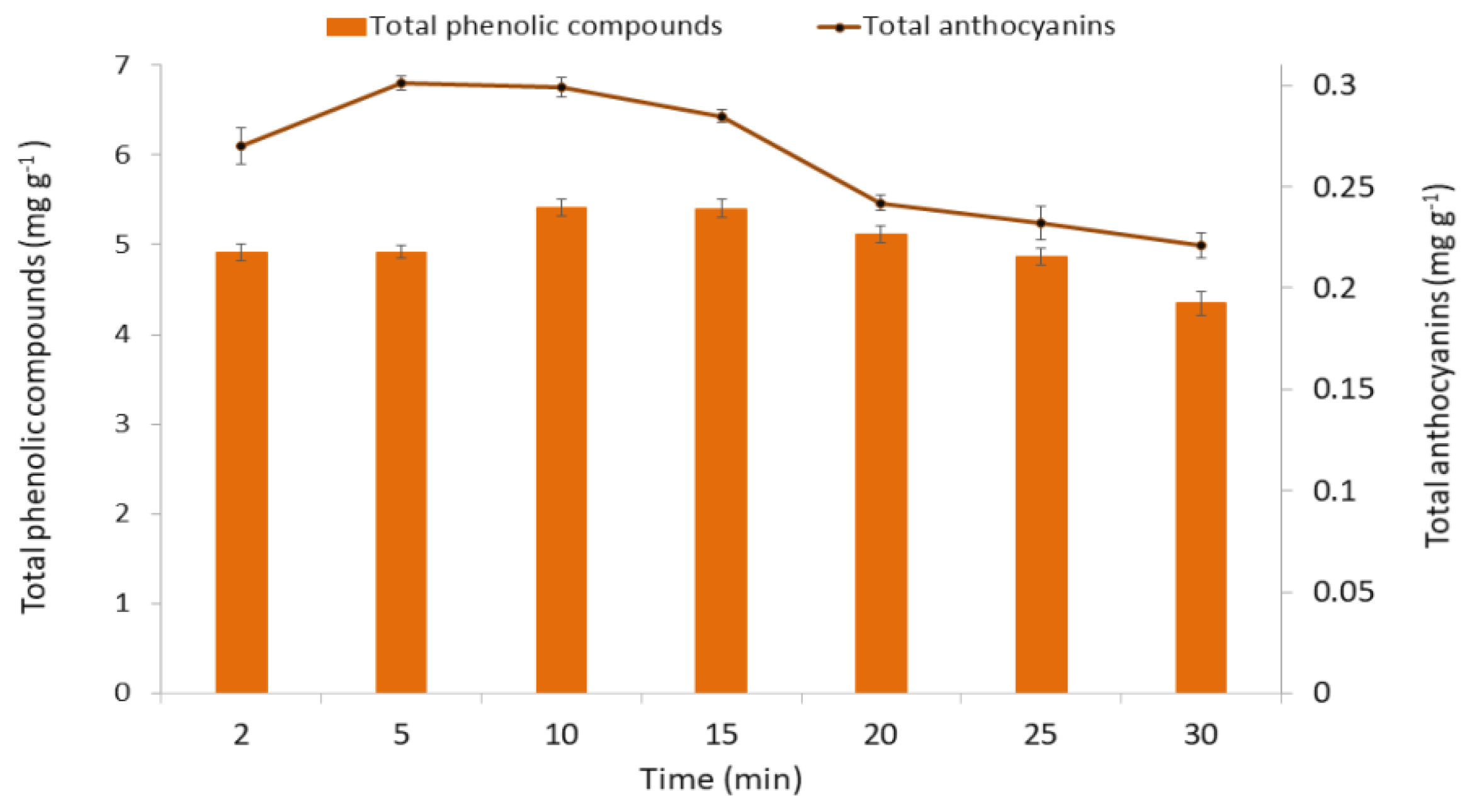
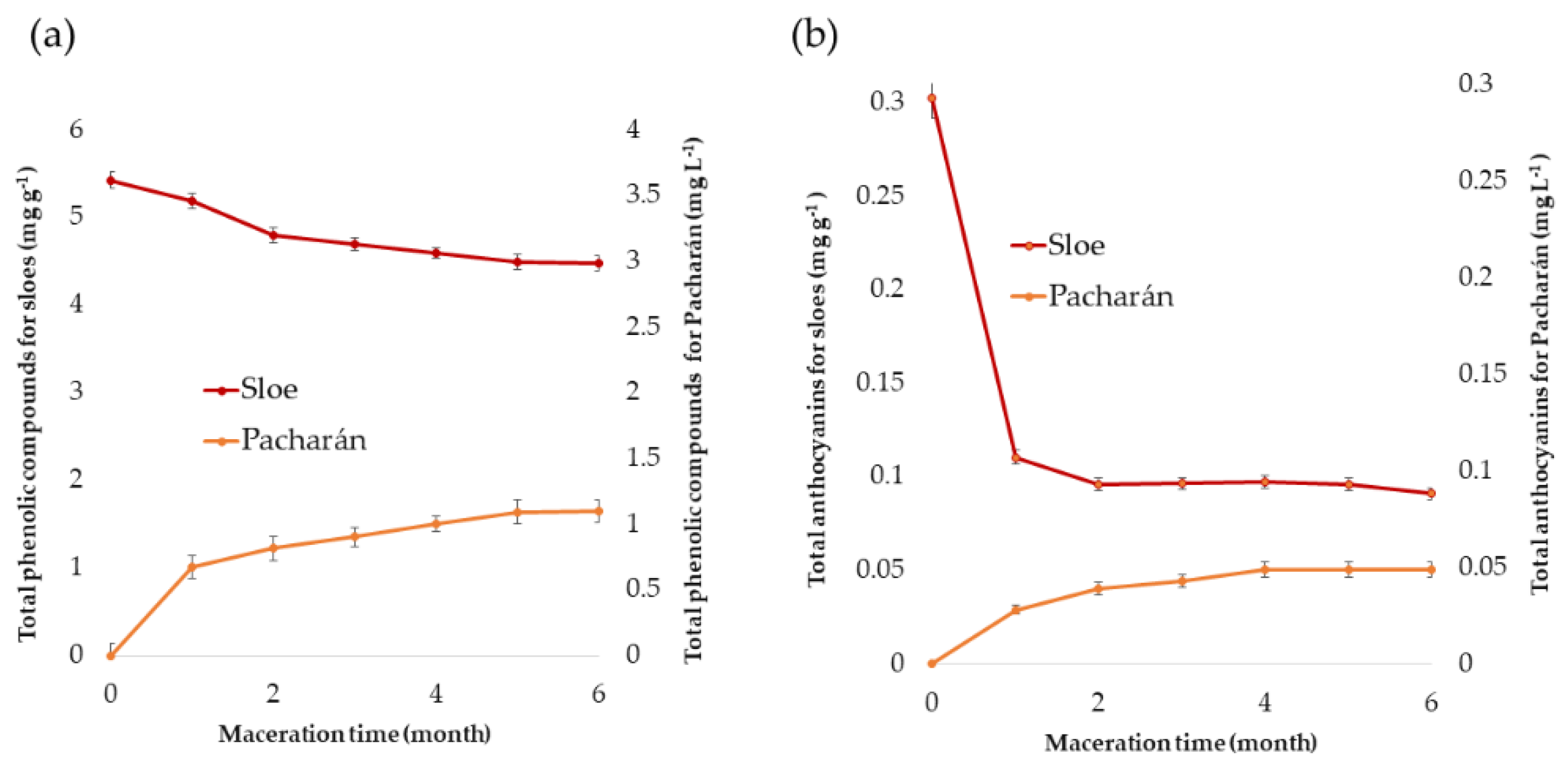

| Run | Factors | Responses | ||||||||
|---|---|---|---|---|---|---|---|---|---|---|
| X1 | X2 | X3 | X4 | X5 | X6 | Total Phenolic Compounds (mg g−1) | Total Anthocyanins (mg g−1) | |||
| Measured | Predicted | Measured | Predicted | |||||||
| 1 | 0 | 0 | −1 | 0 | −1 | −1 | 2.3915 | 2.0892 | 0.2624 | 0.2569 |
| 2 | 0 | 0 | 1 | 0 | −1 | −1 | 2.4783 | 2.0574 | 0.2567 | 0.2568 |
| 3 | 0 | 0 | −1 | 0 | 1 | −1 | 2.0642 | 2.5307 | 0.2128 | 0.23 |
| 4 | 0 | 0 | 1 | 0 | 1 | −1 | 2.2277 | 2.6462 | 0.2422 | 0.2358 |
| 5 | 0 | 0 | −1 | 0 | −1 | 1 | 2.5401 | 2.0099 | 0.2603 | 0.2667 |
| 6 | 0 | 0 | 1 | 0 | −1 | 1 | 2.1814 | 1.8266 | 0.2571 | 0.2398 |
| 7 | 0 | 0 | −1 | 0 | 1 | 1 | 2.3014 | 2.6107 | 0.266 | 0.2659 |
| 8 | 0 | 0 | 1 | 0 | 1 | 1 | 2.1607 | 2.5747 | 0.2394 | 0.2449 |
| 9 | 0 | −1 | 0 | −1 | −1 | 0 | 2.1296 | 2.8548 | 0.2397 | 0.2118 |
| 10 | 0 | 1 | 0 | −1 | −1 | 0 | 1.4982 | 2.8217 | 0.2059 | 0.2172 |
| 11 | 0 | −1 | 0 | 1 | −1 | 0 | 1.9055 | 2.685 | 0.1743 | 0.1791 |
| 12 | 0 | 1 | 0 | 1 | −1 | 0 | 4.0797 | 3.9254 | 0.1511 | 0.1698 |
| 13 | 0 | −1 | 0 | −1 | 1 | 0 | 4.509 | 4.5033 | 0.2029 | 0.1772 |
| 14 | 0 | 1 | 0 | −1 | 1 | 0 | 4.2978 | 3.6783 | 0.161 | 0.1631 |
| 15 | 0 | −1 | 0 | 1 | 1 | 0 | 4.5015 | 3.018 | 0.2297 | 0.2114 |
| 16 | 0 | 1 | 0 | 1 | 1 | 0 | 4.0317 | 3.4665 | 0.1478 | 0.1826 |
| 17 | −1 | 0 | −1 | −1 | 0 | 0 | 2.158 | 2.0663 | 0.1902 | 0.169 |
| 18 | 1 | 0 | −1 | −1 | 0 | 0 | 4.2215 | 3.3884 | 0.0927 | 0.1158 |
| 19 | −1 | 0 | 1 | −1 | 0 | 0 | 1.736 | 1.8218 | 0.1219 | 0.1179 |
| 20 | 1 | 0 | 1 | −1 | 0 | 0 | 4.4504 | 3.3737 | 0.0933 | 0.1077 |
| 21 | −1 | 0 | −1 | 1 | 0 | 0 | 1.7737 | 2.3272 | 0.1509 | 0.143 |
| 22 | 1 | 0 | −1 | 1 | 0 | 0 | 2.117 | 2.5545 | 0.0928 | 0.0904 |
| 23 | −1 | 0 | 1 | 1 | 0 | 0 | 1.9642 | 2.2742 | 0.1466 | 0.13 |
| 24 | 1 | 0 | 1 | 1 | 0 | 0 | 2.1164 | 2.7312 | 0.1056 | 0.1204 |
| 25 | 0 | −1 | −1 | 0 | 0 | −1 | 2.0109 | 1.8537 | 0.1758 | 0.1768 |
| 26 | 0 | 1 | −1 | 0 | 0 | −1 | 2.0568 | 2.0524 | 0.1561 | 0.1596 |
| 27 | 0 | −1 | 1 | 0 | 0 | −1 | 1.8645 | 1.8832 | 0.1671 | 0.1824 |
| 28 | 0 | 1 | 1 | 0 | 0 | −1 | 2.0539 | 2.1065 | 0.1611 | 0.1598 |
| 29 | 0 | −1 | −1 | 0 | 0 | 1 | 1.7983 | 1.8574 | 0.1902 | 0.1915 |
| 30 | 0 | 1 | −1 | 0 | 0 | 1 | 1.9564 | 2.0494 | 0.206 | 0.1907 |
| 31 | 0 | −1 | 1 | 0 | 0 | 1 | 1.8427 | 1.7354 | 0.1735 | 0.1701 |
| 32 | 0 | 1 | 1 | 0 | 0 | 1 | 1.9067 | 1.9521 | 0.1649 | 0.164 |
| 33 | −1 | −1 | 0 | 0 | −1 | 0 | 1.504 | 0.9992 | 0.1238 | 0.14 |
| 34 | 1 | −1 | 0 | 0 | −1 | 0 | 1.9079 | 1.8053 | 0.1011 | 0.1091 |
| 35 | −1 | 1 | 0 | 0 | −1 | 0 | 1.9102 | 1.4451 | 0.1508 | 0.1446 |
| 36 | 1 | 1 | 0 | 0 | −1 | 0 | 2.5599 | 2.5666 | 0.1092 | 0.1007 |
| 37 | −1 | −1 | 0 | 0 | 1 | 0 | 1.9107 | 2.0641 | 0.1174 | 0.1329 |
| 38 | 1 | −1 | 0 | 0 | 1 | 0 | 2.0967 | 2.7218 | 0.1009 | 0.1141 |
| 39 | −1 | 1 | 0 | 0 | 1 | 0 | 1.7755 | 1.7181 | 0.1328 | 0.1179 |
| 40 | 1 | 1 | 0 | 0 | 1 | 0 | 2.3466 | 2.6913 | 0.1092 | 0.0861 |
| 41 | −1 | 0 | 0 | −1 | 0 | −1 | 1.8886 | 1.5898 | 0.1402 | 0.1507 |
| 42 | 1 | 0 | 0 | −1 | 0 | −1 | 2.5955 | 3.1048 | 0.133 | 0.1246 |
| 43 | −1 | 0 | 0 | 1 | 0 | −1 | 1.8057 | 2.077 | 0.1419 | 0.1392 |
| 44 | 1 | 0 | 0 | 1 | 0 | −1 | 3.0502 | 2.4971 | 0.1368 | 0.1137 |
| 45 | −1 | 0 | 0 | −1 | 0 | 1 | 1.6928 | 1.7228 | 0.1315 | 0.1611 |
| 46 | 1 | 0 | 0 | −1 | 0 | 1 | 2.8301 | 3.0819 | 0.1276 | 0.1239 |
| 47 | −1 | 0 | 0 | 1 | 0 | 1 | 1.9351 | 1.949 | 0.1568 | 0.1587 |
| 48 | 1 | 0 | 0 | 1 | 0 | 1 | 2.4375 | 2.2132 | 0.1262 | 0.1222 |
| 49 | 0 | 0 | 0 | 0 | 0 | 0 | 1.9379 | 2.0819 | 0.1249 | 0.1472 |
| 50 | 0 | 0 | 0 | 0 | 0 | 0 | 2.1396 | 2.0819 | 0.1588 | 0.1472 |
| 51 | 0 | 0 | 0 | 0 | 0 | 0 | 2.1572 | 2.0819 | 0.1433 | 0.1472 |
| 52 | 0 | 0 | 0 | 0 | 0 | 0 | 1.8919 | 2.0819 | 0.1233 | 0.1472 |
| 53 | 0 | 0 | 0 | 0 | 0 | 0 | 2.3289 | 2.0819 | 0.1888 | 0.1472 |
| 54 | 0 | 0 | 0 | 0 | 0 | 0 | 2.0362 | 2.0819 | 0.1443 | 0.1472 |
| Source | Coefficient | Sum of Squares | Degrees of Freedom | Mean Square | F-Value | p-Value | |
|---|---|---|---|---|---|---|---|
| Model | 2.08 | 22.59 | 27 | 0.8366 | 1.81 | 0.0677 | |
| Methanol | X1 | 0.4448 | 4.75 | 1 | 4.75 | 10.26 | 0.0036 |
| Temperature | X2 | 0.1038 | 0.2588 | 1 | 0.2588 | 0.5591 | 0.4613 |
| Amplitude | X3 | −0.0170 | 0.0069 | 1 | 0.0069 | 0.0149 | 0.9038 |
| Cycle | X4 | −0.0954 | 0.2184 | 1 | 0.2184 | 0.4718 | 0.4982 |
| pH | X5 | 0.2974 | 2.12 | 1 | 2.12 | 4.59 | 0.0418 |
| Ratio | X6 | −0.0377 | 0.0341 | 1 | 0.0341 | 0.0737 | 0.7882 |
| Methanol × Temperature | X1X2 | 0.0789 | 0.0498 | 1 | 0.0498 | 0.1075 | 0.7456 |
| Methanol × Amplitude | X1X3 | 0.0575 | 0.0264 | 1 | 0.0264 | 0.0571 | 0.813 |
| Methanol × Cycle | X1X4 | −0.2737 | 1.2 | 1 | 1.2 | 2.59 | 0.1196 |
| Methanol × pH | X1X5 | −0.0371 | 0.011 | 1 | 0.011 | 0.0237 | 0.8787 |
| Methanol × Ratio | X1X6 | −0.0390 | 0.0121 | 1 | 0.0121 | 0.0262 | 0.8726 |
| Temperature × Amplitude | X2X3 | 0.0062 | 0.0003 | 1 | 0.0003 | 0.0007 | 0.9797 |
| Temperature × Cycle | X2X4 | 0.3184 | 0.8109 | 1 | 0.8109 | 1.75 | 0.1971 |
| Temperature × pH | X2X5 | −0.1980 | 0.627 | 1 | 0.627 | 1.35 | 0.255 |
| Temperature × Ratio | X2X6 | −0.0016 | 0 | 1 | 0 | 0 | 0.9946 |
| Amplitude × Cycle | X3X4 | 0.0479 | 0.0183 | 1 | 0.0183 | 0.0396 | 0.8438 |
| Amplitude × pH | X3X5 | 0.0368 | 0.0109 | 1 | 0.0109 | 0.0235 | 0.8795 |
| Amplitude × Ratio | X3X6 | −0.0379 | 0.0229 | 1 | 0.0229 | 0.0495 | 0.8256 |
| Cycle × pH | X4X5 | −0.3289 | 0.8653 | 1 | 0.8653 | 1.87 | 0.1832 |
| Cycle × Ratio | X4X6 | −0.0653 | 0.0341 | 1 | 0.0341 | 0.0736 | 0.7883 |
| pH × Ratio | X5X6 | 0.0398 | 0.0127 | 1 | 0.0127 | 0.0274 | 0.8698 |
| Methanol × Methanol | X12 | −0.4724 | 2.3 | 1 | 2.3 | 4.96 | 0.0348 |
| Temperature × Temperature | X22 | 0.0175 | 0.0031 | 1 | 0.0031 | 0.0068 | 0.9349 |
| Amplitude × Amplitude | X32 | 0.0623 | 0.0399 | 1 | 0.0399 | 0.0862 | 0.7714 |
| Cycle × Cycle | X42 | 0.8953 | 8.24 | 1 | 8.24 | 17.81 | 0.0003 |
| pH × pH | X52 | 0.3744 | 1.44 | 1 | 1.44 | 3.12 | 0.0893 |
| Ratio × Ratio | X62 | −0.2254 | 0.5227 | 1 | 0.5227 | 1.13 | 0.2976 |
| Residual | 2.08 | 12.03 | 26 | 0.4628 | |||
| Lack of Fit | 0.4448 | 11.9 | 21 | 0.5669 | 21.98 | 0.0014 | |
| Pure Error | 0.1038 | 0.1289 | 5 | 0.0258 | |||
| Total | −0.0170 | 34.62 | 53 |
| Source | Coefficient | Sum of Squares | Degrees of Freedom | Mean Square | F-Value | p-Value | |
|---|---|---|---|---|---|---|---|
| Model | 0.1472 | 0.1163 | 27 | 0.0043 | 8.83 | <0.0001 | |
| Methanol | X1 | −0.0157 | 0.0059 | 1 | 0.0059 | 12.09 | 0.0018 |
| Temperature | X2 | −0.0059 | 0.0008 | 1 | 0.0008 | 1.68 | 0.2057 |
| Amplitude | X3 | −0.0053 | 0.0007 | 1 | 0.0007 | 1.37 | 0.252 |
| Cycle | X4 | −0.0033 | 0.0003 | 1 | 0.0003 | 0.5381 | 0.4698 |
| pH | X5 | −0.0054 | 0.0007 | 1 | 0.0007 | 1.45 | 0.2395 |
| Ratio | X6 | 0.0047 | 0.0005 | 1 | 0.0005 | 1.1 | 0.3044 |
| Methanol × Temperature | X1X2 | −0.0033 | 0.0001 | 1 | 0.0001 | 0.1731 | 0.6808 |
| Methanol × Amplitude | X1X3 | 0.0108 | 0.0009 | 1 | 0.0009 | 1.89 | 0.1805 |
| Methanol × Cycle | X1X4 | 0.0001 | 3.60E-07 | 1 | 3.60E-07 | 0.0007 | 0.9785 |
| Methanol × pH | X1X5 | 0.003 | 0.0001 | 1 | 0.0001 | 0.15 | 0.7017 |
| Methanol × Ratio | X1X6 | −0.0028 | 0.0001 | 1 | 0.0001 | 0.1262 | 0.7253 |
| Temperature × Amplitude | X2X3 | −0.0013 | 0 | 1 | 0 | 0.0293 | 0.8654 |
| Temperature × Cycle | X2X4 | −0.0037 | 0.0001 | 1 | 0.0001 | 0.2213 | 0.642 |
| Temperature × pH | X2X5 | −0.0049 | 0.0004 | 1 | 0.0004 | 0.7829 | 0.3844 |
| Temperature × Ratio | X2X6 | 0.0041 | 0.0001 | 1 | 0.0001 | 0.2772 | 0.603 |
| Amplitude × Cycle | X3X4 | 0.0095 | 0.0007 | 1 | 0.0007 | 1.49 | 0.2337 |
| Amplitude × pH | X3X5 | 0.0015 | 0 | 1 | 0 | 0.0351 | 0.8529 |
| Amplitude × Ratio | X3X6 | −0.0067 | 0.0007 | 1 | 0.0007 | 1.48 | 0.2343 |
| Cycle × pH | X4X5 | 0.0167 | 0.0022 | 1 | 0.0022 | 4.58 | 0.0418 |
| Cycle × Ratio | X4X6 | 0.0023 | 0 | 1 | 0 | 0.0867 | 0.7708 |
| pH × Ratio | X5X6 | 0.0065 | 0.0003 | 1 | 0.0003 | 0.6951 | 0.412 |
| Methanol × Methanol | X12 | −0.0566 | 0.0329 | 1 | 0.0329 | 67.42 | <0.0001 |
| Temperature × Temperature | X22 | −0.0239 | 0.0059 | 1 | 0.0059 | 12.03 | 0.0018 |
| Amplitude × Amplitude | X32 | 0.0192 | 0.0038 | 1 | 0.0038 | 7.81 | 0.0096 |
| Cycle × Cycle | X42 | 0.0143 | 0.0021 | 1 | 0.0021 | 4.33 | 0.0475 |
| pH × pH | X52 | 0.0514 | 0.0272 | 1 | 0.0272 | 55.62 | <0.0001 |
| Ratio × Ratio | X62 | 0.0318 | 0.0104 | 1 | 0.0104 | 21.24 | <0.0001 |
| Residual | 0.1472 | 0.0127 | 26 | 0.0005 | |||
| Lack of Fit | −0.0157 | 0.0097 | 21 | 0.0005 | 0.7838 | 0.6888 | |
| Pure Error | −0.0059 | 0.003 | 5 | 0.0006 | |||
| Total | −0.0053 | 0.129 | 53 |
© 2020 by the authors. Licensee MDPI, Basel, Switzerland. This article is an open access article distributed under the terms and conditions of the Creative Commons Attribution (CC BY) license (http://creativecommons.org/licenses/by/4.0/).
Share and Cite
V. González-de-Peredo, A.; Vázquez-Espinosa, M.; Espada-Bellido, E.; Ferreiro-González, M.; Carrera, C.; Palma, M.; Álvarez, J.Á.; F. Barbero, G.; Ayuso, J. Optimization of Analytical Ultrasound-Assisted Methods for the Extraction of Total Phenolic Compounds and Anthocyanins from Sloes (Prunus spinosa L.). Agronomy 2020, 10, 966. https://doi.org/10.3390/agronomy10070966
V. González-de-Peredo A, Vázquez-Espinosa M, Espada-Bellido E, Ferreiro-González M, Carrera C, Palma M, Álvarez JÁ, F. Barbero G, Ayuso J. Optimization of Analytical Ultrasound-Assisted Methods for the Extraction of Total Phenolic Compounds and Anthocyanins from Sloes (Prunus spinosa L.). Agronomy. 2020; 10(7):966. https://doi.org/10.3390/agronomy10070966
Chicago/Turabian StyleV. González-de-Peredo, Ana, Mercedes Vázquez-Espinosa, Estrella Espada-Bellido, Marta Ferreiro-González, Ceferino Carrera, Miguel Palma, José Ángel Álvarez, Gerardo F. Barbero, and Jesús Ayuso. 2020. "Optimization of Analytical Ultrasound-Assisted Methods for the Extraction of Total Phenolic Compounds and Anthocyanins from Sloes (Prunus spinosa L.)" Agronomy 10, no. 7: 966. https://doi.org/10.3390/agronomy10070966
APA StyleV. González-de-Peredo, A., Vázquez-Espinosa, M., Espada-Bellido, E., Ferreiro-González, M., Carrera, C., Palma, M., Álvarez, J. Á., F. Barbero, G., & Ayuso, J. (2020). Optimization of Analytical Ultrasound-Assisted Methods for the Extraction of Total Phenolic Compounds and Anthocyanins from Sloes (Prunus spinosa L.). Agronomy, 10(7), 966. https://doi.org/10.3390/agronomy10070966










